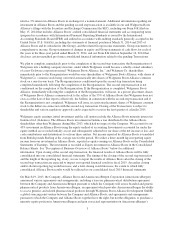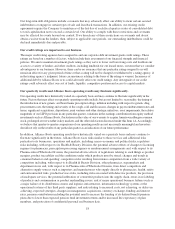Walgreens 2014 Annual Report Download - page 21
Download and view the complete annual report
Please find page 21 of the 2014 Walgreens annual report below. You can navigate through the pages in the report by either clicking on the pages listed below, or by using the keyword search tool below to find specific information within the annual report.Changes in economic conditions could adversely affect consumer buying practices and reduce our
revenues and profitability.
Our performance has been, and may continue to be, adversely impacted by negative changes in national, regional
or local economic conditions and consumer confidence. The current economic environment has had a material
impact on consumer behavior that could persist even as the economy recovers. External factors that affect
consumer confidence and over which we exercise no influence include unemployment rates, levels of personal
disposable income, national, regional or local economic conditions and acts of war or terrorism. Changes in
economic conditions and consumer confidence could adversely affect consumer preferences, purchasing power
and spending patterns. A decrease in overall consumer spending as a result of changes in economic conditions
could adversely affect our front-end and pharmacy sales and negatively impact our profitability. All these factors
could impact our revenues, operating results and financial condition.
The industries in which we operate are highly competitive and further increases in competition could
adversely affect us.
In our retail drugstore business, we face intense competition from local, regional and national companies,
including other drugstore chains, independent drugstores, mail-order prescription providers and various other
retailers such as grocery stores, convenience stores, mass merchants and dollar stores, many of which are
aggressively expanding in markets we serve. In the other markets in which we compete, including health and
wellness services, we also operate in a highly competitive environment. As competition increases in the markets
in which we operate, a significant increase in general pricing pressures could occur, and this could require us to
reevaluate our pricing structures to remain competitive. Our failure to reduce prices could result in decreased
revenue and negatively affect our profitability.
If the merchandise and services that we offer fail to meet customer needs, our sales may be adversely
affected.
Our success depends on our ability to offer a superior shopping experience, a quality assortment of available
merchandise and superior customer service. We must identify, obtain supplies of, and offer to our customers,
attractive, innovative and high-quality merchandise on a continuous basis. Our products and services must satisfy
the needs and desires of our customers, whose preferences may change in the future. It is difficult to predict
consistently and successfully the products and services our customers will demand. If we misjudge either the
demand for products and services we sell or our customers’ purchasing habits and tastes, we may be faced with
excess inventories of some products and missed opportunities for products and services we chose not to offer. In
addition, our sales may decline or we may be required to sell the merchandise we have obtained at lower
prices. Failure to timely identify or effectively respond to changing consumer tastes, preferences and spending
patterns could negatively affect our relationship with our customers, the demand for our products and services
and our market share.
Our private brand offerings expose us to various additional risks.
In addition to brand name products, we offer our customers private brand products that are not available from
other retailers. We seek to continue to grow our exclusive private brand offerings as part of our growth strategy,
including through expanded offering of Boots No7 and other brands owned or licensed on an exclusive basis by
Alliance Boots. Maintaining consistent product quality, competitive pricing, and availability of our private brand
offerings for our customers is important in developing and maintaining customer loyalty. We have invested in
our development and procurement resources and marketing efforts relating to these private brand offerings.
Although we believe that our private brand products offer value to our customers at each price point and typically
provide us with higher gross margins than comparable national brand products we sell, the expansion of our
private brand offerings also subjects us to certain risks in addition to those discussed elsewhere in this section,
such as: potential product liability risks and mandatory or voluntary product recalls; our ability to successfully
protect our proprietary rights and successfully navigate and avoid claims related to the proprietary rights of third
parties; our ability to successfully administer and comply with applicable contractual obligations and regulatory
13
























